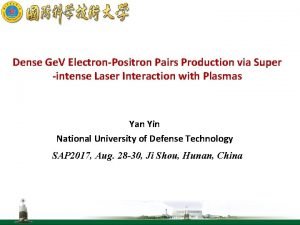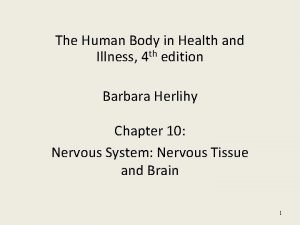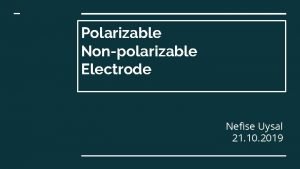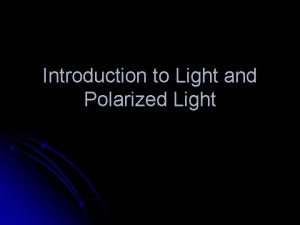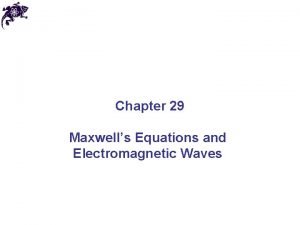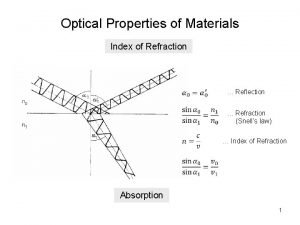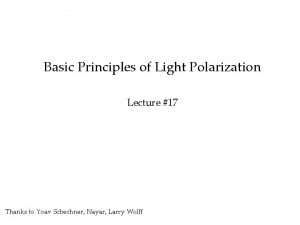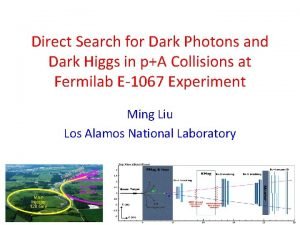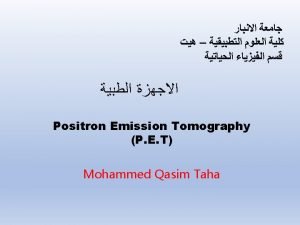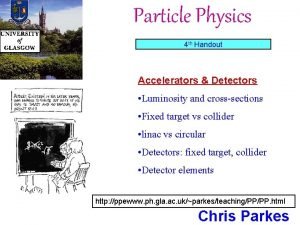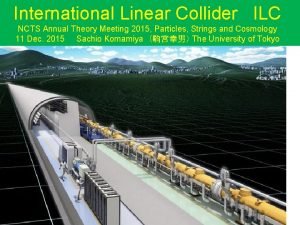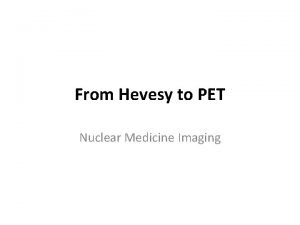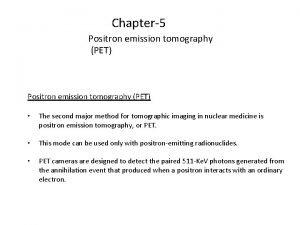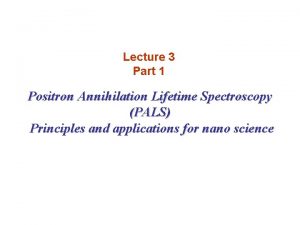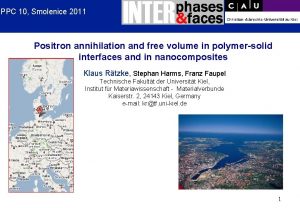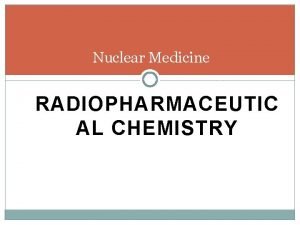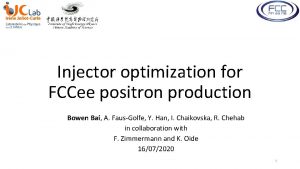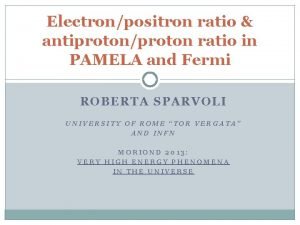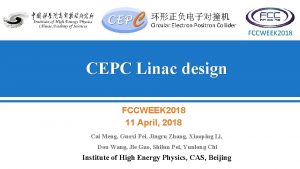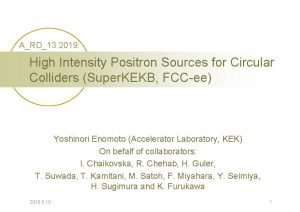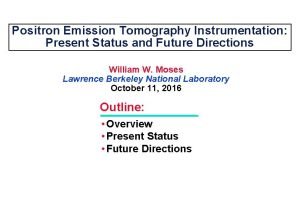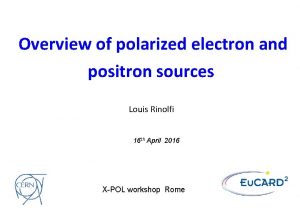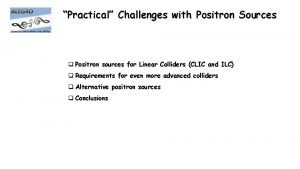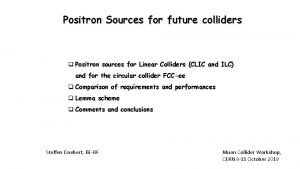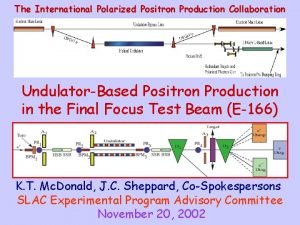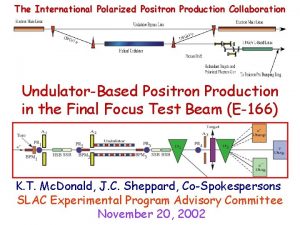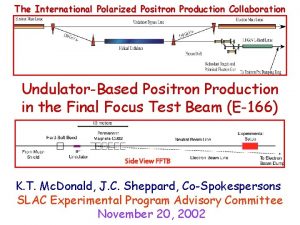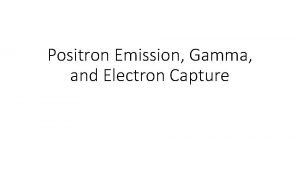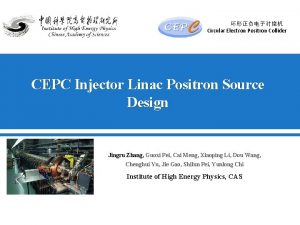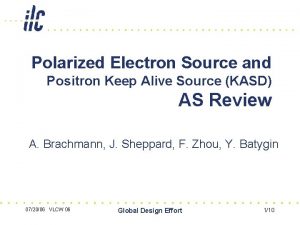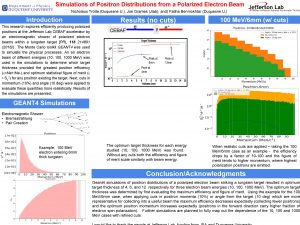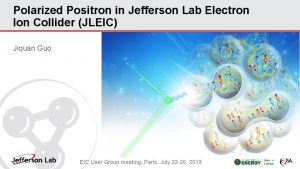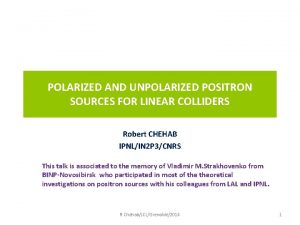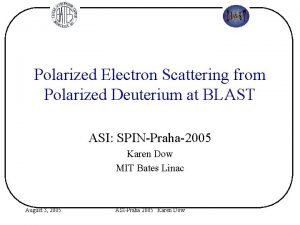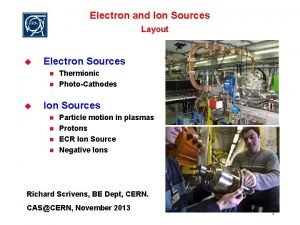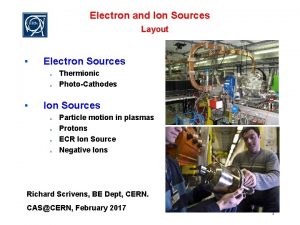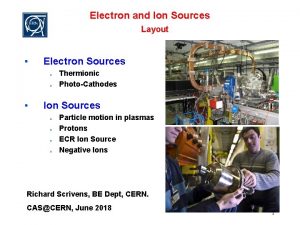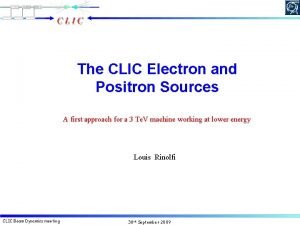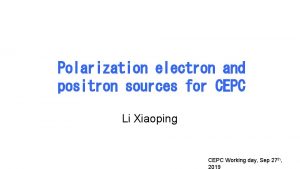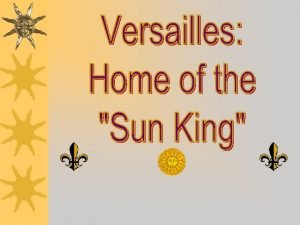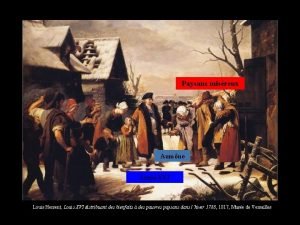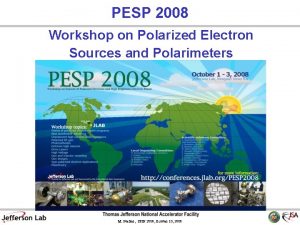Overview of polarized electron and positron sources Louis






















![FCC-ee parameters Y. Papaphilippou - FCC week 2016 Accelerator Energy [Ge. V] Type of FCC-ee parameters Y. Papaphilippou - FCC week 2016 Accelerator Energy [Ge. V] Type of](https://slidetodoc.com/presentation_image_h2/6381134e69f5859714f63a744ebf8685/image-23.jpg)


- Slides: 25

Overview of polarized electron and positron sources Louis Rinolfi 16 th April 2016 X-POL workshop Rome

Contents • • General concepts to produce polarized e- and e+ beams Overview of polarized electron and positron sources Polarized sources challenges for future high energy colliders Summary The unpolarized electron and positron sources, with all related challenges are not discussed here.

Method to produce polarized e. Laser Photocathode Ga. AS with superlattice e- beam E = 5 - 10 Me. V Electric field DC or RF Cesiated Ga. As is the only material for polarized electrons with Ga. As/Ga. As. P superlattice crystal => 95 % polarization possible

Some key parameters for polarized e- source ØPhotocathode • • High quantum efficiency Long life time ØDrive laser • • Reliable Synchronization with the machine Sufficient power Wavelength tunable ØVacuum • Good dynamic vacuum (with beam on) ØElectric field • Avoid break down and field emission

SLC photogun for polarized e. J. Clendenin / SLAC

MAMI photogun for polarized e. K. Aulenbacher / Mainz IPAC 2014 Dresden

ELBE photogun for polarized e. J. Teichert / HZDR Superconducting RF gun at Rossendorf Parameter ELBE High Charge final electron energy ≤ 9. 5 Me. V RF frequency 1. 3 GHz operation mode CW Photo cathode Cs 2 Te bunch charge 77 p. C 1 n. C repetition rate 13 MHz 500 k. Hz laser pulse (FWHM) 4 ps 15 ps transverse rms emittance 1 mm mrad 2. 5 mm mrad average current 1 m. A 0. 5 m. A

Building 350 k. V DC gun at JLAB 500 k. V DC gun in Japan Collaboration KEK / JAEA / Nagoya • Stable operation at 500 k. V has been confirmed. • 10 m. A beam generation has been demonstrated. • The gun in c. ERL commissioning shows good performances.

New Strain-Compensated Super-Lattice N. Yamamoto / Nagoya U. POSIPOL 2014 500 k. V DC gun @ KEK => 6. 9 MV/m Achieved results: Max Pol. 92 % Max QE 2. 2 %

Source parameter comparison Polarized e- beams M. Poelker / JLAB

High current beam at Cornell • Peak current of 75 m. A (world record) G. Hoffstaetter / FCC week 2016 - Rome • Na. KSb photocathode • High rep-rate laser • DC-Voltage source Source achievements: • 2. 6 day 1/e lifetime at 65 m. A • 8 h at 65 m. A • With only 5 W laser power (20 W are available) • now pushing to 100 m. A Simulations accurately reproduce photocathode performance with no free parameters, and suggest strategies for further improvement. Source current can meet ERL needs

Methods to produce polarized e+ 1) Radiation from helical undulator 2) Compton backscattering of circularly polarized laser photons by relativistic electrons 3) Synchrotron radiation from a dipole magnet 4) Bremsstrahlung from longitudinally polarized electrons (PEPPo collaboration at JLAB) We will mention mainly the two first methods

For future high energy colliders 1) Helical undulator e- e- beam E > 100 Ge. V g rays E = 10 -20 Me. V L > 100 m e+ 2) Compton backscattering with laser Laser e- @10 Mev => g @ 10 ke. V e- beam e- E = 1 - 6 Ge. V g rays E = 10 -60 Me. V e+ e- @ 1 Gev => g @ 10 Me. V

Some key parameters for a polarized e+ source independent of g rays production (where many challenges exist not discussed here) ØPhotons impinging on the target • • Energy Collimation ØTarget • • • Appropriate Z material Thermal stress Shock stress ØMatching device • Adiabatic ØRadiation issues • Shielding

Two large colliders ran with polarized e+ SLC LEP 2 Collider Linear Circular Shut-down 1998 2000 91 104 Max c. m. energy (Ge. V) Leptons Polarization at source Polarization at IP Number of bunches Polarization measured (%) e- e+ Yes No No No Yes Yes Self-polarized Sokolov. Ternov DC gun 1 1 4 4 ~ 85 0 ~ 50 Future lepton colliders (ILC, CLIC, LHe. C, Cep. C, FCC-ee, …. ) require polarized e + beams

ILC Positron Source (TDR) Positron source is located at end of main linac and uses e- beam • Superconducting helical undulator – K=0. 92, l=1. 15 cm, (B=0. 86 T on the axis), aperture 5. 85 mm – Max 231 m active length • e+ Production Target – 400 m downstream the undulator – 0. 4 X 0 Ti alloy • Positron Capture: Pulsed flux concentrator + capture RF • Alternative: quarter wave transformer + capture RF • e+ polarization – By default: ~30% – Polarization upgrade possible up to ~ 60% with a photon collimator

ILC Polarization upgrade W. Gai / ANL 231 m RDR undulator, 150 Ge. V drive beam, ¼ wave transformer With QWT, with a photon collimator to upgrade the polarization to 60%, the positron yield will drop to ~0. 8

ILC positron polarization Demonstration with E-166 experiment at SLAC S. Riemann / DESY R. Pitthan & J. Sheppard / SLAC Polarization of 80% was measured for e+ (and e-) in the range 4 – 8 Me. V

CLIC Positron Source Compton configuration for polarized e+ 2. 424 Ge. V e+ DR 2. 424 Ge. V 20 turns makes 312 bunches with 4. 4 x 109 e+/bunch 1. 06 Ge. V 1 YAG Laser pulse 600 m. J Stacking cavity 2 GHz 50 Hz g g (10 -20 Me. V) 2. 1 x 109 /turn/bunch GHz 2 Pre-injector Linac for e+ 200 Me. V e+ target Compton ring 2 GHz Injector Linac 2. 2 Ge. V Drive Linac RF gun C = 47 m, 156 ns/turn, 312 bunches with 6. 2 x 1010 e-/bunch e+ PDR and Accumulator ring e+ 2. 6 x 108 pol. /turn/bunch

CLIC positron source data CERN-ATS-2009 -086 CLIC Note 788

LHe. C Positron Source (CDR) Three rings transformer for polarized e+ option extraction ring (N turns) fast cooling ring (N turns) accumulator ring (N turns) E. Bulyak et al. “Performance of Compton Sources of Polarised Positrons” Positron for LHe. C - Brainstorming workshop - May 2011

Leptons flux comparison for future colliders SLC CLIC (3 Te. V) ILC (RDR) LHe. C p-140 LHe. C ERL Energy (@ DR) [Ge. V] 1. 19 2. 86 5 140 60 e+/ bunch at IP [109] 40 3. 72 20 1. 6 2 e+/ bunch after capture [109] 50 7. 6 30 1. 8 2. 2 Bunches / macropulse 1 312 2625 105 NA Macropulse repet. rate [Hz] 120 50 5 10 CW Bunches / second 120 15600 13125 106 20 x 106 e+ / second (x 1014) 0. 06 1. 1 3. 9 18 440 x 20 x 65 x 300 x 7000
![FCCee parameters Y Papaphilippou FCC week 2016 Accelerator Energy Ge V Type of FCC-ee parameters Y. Papaphilippou - FCC week 2016 Accelerator Energy [Ge. V] Type of](https://slidetodoc.com/presentation_image_h2/6381134e69f5859714f63a744ebf8685/image-23.jpg)
FCC-ee parameters Y. Papaphilippou - FCC week 2016 Accelerator Energy [Ge. V] Type of filling LINAC # bunches LINAC repetition rate [Hz] LINAC RF freq [MHz] LINAC bunch population [109] # of LINAC injections SPS/BR bunch spacing [MHz] SPS bunches/injection SPS bunch population [1010] SPS duty factor SPS / BR # of bunches SPS / BR cycle time [s] Number of BR cycles Transfer efficiency Total number of bunches Filling time (both species) [sec] Injected bunch population [1010] FCCee-Z FCCee-W FCCee-H 45. 6 80 120 Full Top-up 915 530 195 50 2000 3. 3 0. 38 5 5 4 400 183 106 39 1. 7 0. 19 0. 5 915/4575 530/2650 156/780 1. 2 / 12 50 9 10 2 7 2 0. 8 91500 5260 780 1200 216 240 48 168 48 1. 7 0. 19 FCCee-tt 175 Full Top-up 81 3. 3 0. 38 5 16 1. 7 0. 19 0. 17 81/81 1. 2 / 7. 2 3 1 81 43. 2 14. 4 1. 7 0. 19

Flux for FCC-ee SLC LEP 2 FCC Z FCC W FCC H FCC tt 1. 19 104. 5 45. 5 80 120 175 e / bunch after capture (109) 45 155 3. 3 Bunches / macropulse 1 4 915 530 195 81 120 0. 004 50 50 0. 06 0. 0023 1. 5 0. 9 0. 3 0. 1 Energy (Ge. V) Repetition rate (Hz) e / second (x 1014) x 25 Max requested flux is between CLIC and ILC => would be OK

Summary Polarized electron sources for future high energy colliders: 1) The proposed electron source will depend on the accelerator requirements. 2) Polarized electron source implies photoemission. The choice is between DC versus RF. 3) Today the electron source technology is mature, nevertheless many stimulating problems still need be solved. 4) For FCC-ee, the requested flux and polarization level would be reachable. Polarized positron sources for future high energy colliders: Today the requested flux and polarization present several challenges with the present technology but it would be doable. For FCC-ee, test facilities and experimental measurements are strongly recommended to check the performance of polarized electron and positron sources.
 Positron vs electron
Positron vs electron Vl louis vuitton
Vl louis vuitton Print sources and web sources
Print sources and web sources Brain homunculus
Brain homunculus Non polarizable electrode
Non polarizable electrode What is the light
What is the light Polarized pluralist model
Polarized pluralist model A polarizer blocks 75% of a polarized light beam.
A polarizer blocks 75% of a polarized light beam. Polarized wave
Polarized wave Birefrengence
Birefrengence Photo search
Photo search Importance of water management
Importance of water management Positron emission
Positron emission Positron vs proton
Positron vs proton Positron vs proton
Positron vs proton Positron emission tomography
Positron emission tomography Positron symbol
Positron symbol Gas separation
Gas separation Positron emission tomography
Positron emission tomography Positron yacht
Positron yacht Positron emission tomography
Positron emission tomography Positron
Positron Cirelli
Cirelli Positron
Positron Positron
Positron Positron emission
Positron emission
